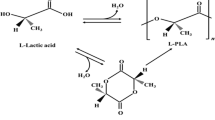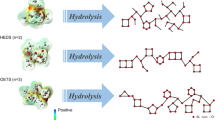Abstract
Compounds with heterocyclic rings and NO2 groups have drawn much attention as high energy density compounds in recent years. In this study, the nitro derivatives 1–4 of epoxyethane (ETO) were investigated, and their synthetic possibilities in thermodynamics and thermal stability were predicted. The trigger bond for 1, 2 and 3 is the C–C bond, but for 4 it is the C–NO2 bond. The bond dissociation energies (E BDs) were estimated to be 205.40–164.86 kJ mol−1 and h 50s were 53–126 cm. E BD, h 50 and energy gap all decrease from 1 to 4. A linear relationship exists between the strain energy and the number of the NO2 group. Derivative 2 has a zero oxygen balance and possesses the best detonation properties (D = 8.77 km s−1 and P = 33.88 GPa) as a single explosive. Derivatives 3 and 4 used as oxidizers in the composite explosives of hexahydro-1,3,5-trinitro-1,3,5-triazine (RDX) produce very good detonation performance (D = 9.36 km s−1, P = 40.15 GPa and I s = 281.56 s for 3/RDX, and D = 9.45 km s−1, P = 41.04 GPa and I s = 280.34 s for 4/RDX). The intermolecular hydrogen bonding and dispersion interactions of 3/RDX and 4/RDX show that the compatibilities of these composites are acceptable.






Similar content being viewed by others
References
Rahm M, Brinck T (2010) Kinetic stability and propellant performance of green energetic materials. Chem-Eur J 16(22):6590–6600
Klapötke TM, Krumm B, Moll R, Rest SF (2011) CHNO based molecules containing 2,2,2-trinitroethoxy moieties as possible high energy dense oxidizers. Z Anorg Allg Chem 637(14–15):2103–2110
Badgujar DM, Talawar MB, Asthana SN, Mahulikar PP (2008) Advances in science and technology of modern energetic materials: an overview. J Hazard Mater 151(2):289–305
Sikder A, Sikder N (2004) A review of advanced high performance, insensitive and thermally stable energetic materials emerging for military and space applications. J Hazard Mater 112(1):1–15
Cui J, Han J, Wang J, Huang R (2010) Study on the crystal structure and hygroscopicity of ammonium dinitramide. J Chem Eng Data 55(9):3229–3234
de Klerk WP, van der Heijden AE, Veltmans WH (2001) Thermal analysis of the high-energetic material HNF. J Therm Anal Calorim 64(3):973–985
Dendage P, Sarwade D, Asthana S, Singh H (2001) Hydrazinium nitroformate (HNF) and HNF based propellants: a review. J Energ Mater 19(1):41–78
Archibald T, Gilardi R, Baum K, George C (1990) Synthesis and X-ray crystal structure of 1, 3, 3-trinitroazetidine. J Org Chem 55(9):2920–2924
McKenney RL Jr, Floyd TG, Stevens WE, Archibald TG, Marchand AP, Sharma G, Bott SG (1998) Synthesis and thermal properties of 1, 3-dinitro-3-(1′, 3′-dinitroazetidin-3′-yl) azetidine (TNDAZ) and its admixtures with 1, 3, 3-trinitroazetidine (TNAZ). J Energ Mater 16(1):1–22
Hiskey MA, Johnson MC, Chavez DE (1999) Preparation of 1-substituted-3, 3-dinitroazetidines. J Energ Mater 17(2–3):233–252
Zhang J, Hu R, Zhu C, Feng G, Long Q (1997) Thermal behavior of 1, 3, 3-trinitroazetidine. Thermochim Acta 298(1):31–35
Pagoria PF, Lee GS, Mitchell AR, Schmidt RD (2002) A review of energetic materials synthesis. Thermochim Acta 384(1):187–204
Coburn MD, Hiskey MA, Archibald TG (1998) Scale-up and waste-minimization of the Los Alamos process for 1, 3, 3-trinitroazetidine (TNAZ). Waste Manag 17(2):143–146
Hayashi K, Kumagai T, Nagao Y (2000) Improved Synthesis of an Energetic Material, 1, 1, 3-Trinitroazetidine Exploiting 1-Azabicyclo [1.1. 0] butane. Heterocycles 53(2):447–452
Coburn MD, Lee K-y (1988) 3-nitro-1, 2, 4-triazol-5-one, a less sensitive explosive. Google Patents
Archibald T, Garver L, Baum K, Cohen M (1989) Synthesis of polynitrocyclobutane derivatives. J Org Chem 54(12):2869–2873
Ivshin V, Komelin M, Tartakovskii V (1999) Synthesis of ()-trans-1, 2, 3-tris (nitroamino) cyclopropane. Russ J Org Chem 35(3):466–467
Chi W, Li L, Li B, Wu H (2012) Density functional calculation on a high energy density compound having the formula C2OH4− n (NO2) n. Struct Chem 23(6):1837–1841
Rice BM, Hare JJ (2002) A quantum mechanical investigation of the relation between impact sensitivity and the charge distribution in energetic molecules. J Phys Chem A 106(9):1770–1783
Frisch MJ, Trucks GW, Schlegel HB, Scuseria GE, Robb MA, Cheeseman JR, Montgomery JA TV Jr, Kudin KN, Burant JC, Millam JM, Iyengar SS, Tomasi J, Barone V, Mennucci B, Cossi M, Scalmani G, Rega N, Petersson GA, Nakatsuji H, Hada M, Ehara M, Toyota K, Fukuda R, Hasegawa J, Ishida M, Nakajima T, Honda Y, Kitao O, Nakai H, Klene M, Li X, Knox JE, Hratchian HP, Cross JB, Bakken V, Adamo C, Jaramillo J, Gomperts R, Stratmann RE, Yazyev O, Austin AJ, Cammi R, Pomelli C, Ochterski JW, Ayala PY, Morokuma K, Voth GA, Salvador P, Dannenberg JJ, Zakrzewski VG, Dapprich S, Daniels AD, Strain MC, Farkas O, Malick DK, Rabuck AD, Raghavachari K, Foresman JB, Ortiz JV, Cui Q, Baboul AG, Clifford S, Cioslowski J, Stefanov BB, Liu G, Liashenko A, Piskorz P, Komaromi I, Martin RL, Fox DJ, Keith T, Al-Laham MA, Peng CY, Nanayakkara A, Challacombe M, Gill PMW, Johnson B, Chen W, Wong MW, Gonzalez C, Pople JA (2004) Gaussian 03, Revision C.02. Gaussian, Inc, Wallingford
Takano Y, Houk K (2005) Benchmarking the conductor-like polarizable continuum model (CPCM) for aqueous solvation free energies of neutral and ionic organic molecules. J Chem Theory Comput 1(1):70–77
Glendening E, Badenhoop J, Reed A, Carpenter J, Bohmann J, Morales C, Weinhold F (2001) NBO 5.0. NBO,Version 50,Theoretical Chemistry Institute, University of Wisconsin, Madison, WI
Liu S (2009) Some recent developments in conceptual density functional theory. Chin J Chem Phys 3:590–600
Lu T, Chen F (2012) Multiwfn: a multifunctional wavefunction analyzer. J Comput Chem 33(5):580–592
Politzer P, Martinez J, Murray JS, Concha MC, Toro-Labbe A (2009) An electrostatic interaction correction for improved crystal density prediction. Mol Phys 107(19):2095–2101
Pospíšil M, Vávra P, Concha MC, Murray JS, Politzer P (2011) Sensitivity and the available free space per molecule in the unit cell. J Mol Model 17:2569–2574
Benson SW (1976) Thermochemical kinetics: methods for the estimation of thermochemical data and rate parameters. Wiley, New York
Yao XQ, Hou XJ, Wu GS, Xu YY, Xiang HW, Jiao H, Li YW (2002) Estimation of CC bond dissociation enthalpies of large aromatic hydrocarbon compounds using DFT methods. J Phys Chem A 106(31):7184–7189
Shao J, Cheng X, Yang X (2005) Density functional calculations of bond dissociation energies for removal of the nitrogen dioxide moiety in some nitroaromatic molecules. J Mol Struc-theochem 755(1):127–130
Fan XW, Ju XH, Xia QY, Xiao HM (2008) Strain energies of cubane derivatives with different substituent groups. J Hazard Mater 151(1):255–260
Xu XJ, Zhu WH, Gong XD, Xiao HM (2008) Theoretical studies on new potential high energy density compounds (HEDCs) adamantyl nitrates from gas to solid. Sci China Ser B Chem 51(5):427–439
Wang F, Du HC, Zhang JY, Gong XD (2011) Computational studies on the crystal structure, thermodynamic properties, detonation performance, and pyrolysis mechanism of 2,4,6,8-Tetranitro-1,3,5,7-tetraazacubane as a novel high energy density material. J Phys Chem A 115(42):11788–11795
Rice BM, Pai SV, Hare J (1999) Predicting heats of formation of energetic materials using quantum mechanical calculations. Combust Flame 118(3):445–458
Chase MW Jr (1998) NIST-JANAF Themochemical Tables, Fourth Edition. J Phys Chem Ref Data Monogr 9:1–1951
Dean JA (ed) (1999) Lange’s chemistry handbook. McGraw-Hill, New York
Politzer P, Lane P, Murray JS (2011) Computational characterization of a potential energetic compound: 1, 3, 5, 7-tetranitro-2, 4, 6, 8-tetraazacubane. Cent Eur J Energ Mater 8(1):39–52
Kamlet MJ, Jacobs SJ (1986) A simple method for calculating detonation properties of C-H -N -O explosives. J Chem Phys 48:23–25
Politzer P, Murray JS, Grice ME, Sjoberg P (eds) (1991) Computer-aided design of monopropellants, in Chemistry of energetic materials. Academic, San Diego
Parr RG, Yang W (1984) Density functional approach to the frontier-electron theory of chemical reactivity. J Am Chem Soc 106(14):4049–4050
O Y (2006) Explosives. Beijing Institute of Technology Press
Owens F (1996) Calculation of energy barriers for bond rupture in some energetic molecules. J Mol Struc-theochem 370(1):11–16
Rice BM, Sahu S, Owens FJ (2002) Density functional calculations of bond dissociation energies for NO2 scission in some nitroaromatic molecules. J Mol Struc-theochem 583(1):69–72
Xu XJ, Zhu WH, Xiao HM (2008) Theoretical predictions on the structures and properties for polynitrohexaazaadamantanes (PNHAAs) as potential high energy density compounds (HEDCs). J Mol Struc-theochem 853(1):1–6
Murray JS, Concha MC, Politzer P (2009) Links between surface electrostatic potentials of energetic molecules, impact sensitivities and C–NO2/N–NO2 bond dissociation energies. Mol Phys 107(1):89–97
Liu H, Wang F, Wang G-X, Gong X-D (2012) Theoretical studies of-NH2 and-NO2 substituted dipyridines. J Mol Model 18(10):4639–4647
George P, Trachtman M, Bock CW, Brett AM (1976) An alternative approach to the problem of assessing destabilization energies (strain energies) in cyclic hydrocarbons. Tetrahedron 32(3):317–323
Walker J, Adamson P, Davis S (1999) Comparison of calculated hydrocarbon strain energies using ab initio and composite methods. J Mol Struc-theochem 487(1):145–150
Lewis LL, Turner LL, Salter EA, Magers DH (2002) Computation of the conventional strain energy in oxaziridine. J Mol Struc-theochem 592(1):161–171
Fan XW, Ju XH (2008) Theoretical studies on four-membered ring compounds with NF2, ONO2, N3, and NO2 groups. J Comput Chem 29(4):505–513
Cremer D, Kraka E (1985) Theoretical determination of molecular structure and conformation. 15. Three-membered rings: bent bonds, ring strain, and surface delocalization. J Am Chem Soc 107(13):3800–3810
Eckhardt CJ, Gavezzotti A (2007) Computer simulations and analysis of structural and energetic features of some crystalline energetic materials. J Phys Chem B 111(13):3430–3437
Politzer P, Murray JS (2014) Impact sensitivity and crystal lattice compressibility/free space. J Mol Model 20(5):1–8
Payne MC, Teter MP, Allan DC, Arias T, Joannopoulos J (1992) Iterative minimization techniques for ab initio total-energy calculations: molecular dynamics and conjugate gradients. Rev Mod Phys 64(4):1045–1097
Ju X-H, Wang Z-Y, Yan X-F, Xiao H-M (2007) Density functional theory studies on dioxygen difluoride and other fluorine/oxygen binary compounds: availability and shortcoming. J Mol Struc-theochem 804(1):95–100
Talawar MB, Sivabalan R, Mukundan T, Muthurajan H, Sikder AK, Gandhe BR, Rao AS (2009) Environmentally compatible next generation green energetic materials (GEMs). J Hazard Mater 161(2):589–607
Zhang Z, Wang B, Ji Y, Zhou Y, Zhou C, Liu Q, Zhu C (2008) Domestic research progress in part of new high energy density materials. Chinese J Explos Propell 31(2):93–97
Liu J, Yang Y, Xin W (2009) Computational investigation on energy characteristics of propellant contains 1, 3, 3-trinitroazetidine. J Solid Rocket Technol 32(3):318–322
Wang F, H-c D, Zhang J-Y, Gong X-D (2011) Comparative theoretical studies of energetic azo s-triazines. J Phys Chem A 115(42):11852–11860
Grimme S, Antony J, Ehrlich S, Krieg H (2010) A consistent and accurate ab initio parametrization of density functional dispersion correction (DFT-D) for the 94 elements H-Pu. J Chem Phys 132(15):154104
Li J, Fan X, Fan X, Zhao F, Hu R (2006) Compatibility study of 1, 3, 3-trinitroazetidinewith some energetic components and inert materials. J Therm Anal Calorim 85(3):779–784
Author information
Authors and Affiliations
Corresponding author
Rights and permissions
About this article
Cite this article
Zhang, X., Gong, X. Theoretical studies on the stability, detonation performance and possibility of synthesis of the nitro derivatives of epoxyethane. J Mol Model 20, 2327 (2014). https://doi.org/10.1007/s00894-014-2327-0
Received:
Accepted:
Published:
DOI: https://doi.org/10.1007/s00894-014-2327-0




